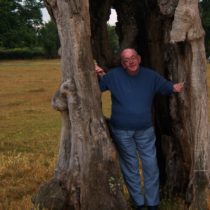Landscape Architecture for Landscape Architects › Forums › TECHNOLOGY › Site Survey Equipment
- This topic has 1 reply, 12 voices, and was last updated 9 years ago by
 Eric Gilbey.
Eric Gilbey.
-
AuthorPosts
-
September 1, 2011 at 1:33 am #160628
 Andrew Garulay, RLAParticipant
Andrew Garulay, RLAParticipantDoes anyone have any good techniques or equipment for locating details on a site to supplement a low detail survey or update existing conditions? Sometimes it just is not worth it to bring in a survey crew or the turnaround time is more than you can stand. On the other hand, the amount of time it takes to draft the measurements into a drawing can be pretty bad as well.
I’ve been doing it with laser distance meters for the last several years (they are getting better and cheaper,for those that don’t have one). I do pretty well with it, but it can get pretty time consuming. I was talking to a surveyor yesterday and he was telling me that reflectorless total stations have come down a great deal and no longer need excessive additional equipment. He thought that I should look into a used setup. The advantage of downloading points rather than plotting out circles or endless offsets from buildings could pay for itself in not a lot of time depending how much you do.
Is anyone using a total station or other equipment or techniques to speed up site measurement and drafting?
September 1, 2011 at 2:01 am #160688 Eric GilbeyParticipant
Eric GilbeyParticipantI have heard great feedback from Trimble’s Total Station system. In the past, I recall taking measurements and elevations with long tapes and the typical rod and level…these total stations take the site info very quickly…the coordinate and elevational position at the same time. This data is easily imported into most CAD solutions. I just recently met a design/build company in Florence, KY that uses it on every project and not only can instantly map out locations and edges of features, they can use the elevational attributes to immediately form a 3D site model of the site too!
September 1, 2011 at 2:15 am #160687Chupacabra
ParticipantI’d go with reflectorless TS if you have access to it. Depending on how much precision and accuracy you need, you might be able to get by with a good handheld GPS.
September 1, 2011 at 2:51 am #160686Anonymous
InactiveI’m just terrified that I’m going to get hit with a law suit. If the project is more than a planting plan or a flat front yard of a residence I insist on a survey. I was told a long time ago that it isn’t smart for an LA to take on that kind of liability. I’m curious to know if that general rule still applies. I enjoy doing site measurements because it’s a great excuse to get out of the office.
September 1, 2011 at 3:18 am #160685 Alan Ray, RLAParticipant
Alan Ray, RLAParticipantI do absoultely NO const. drawings without a certified survey…
I’ll conceptualize all day without a survey but when it’s time to do const. drawings, I insist on a survey or I will not continue……take note, save yourself!
September 1, 2011 at 3:40 am #160684 Jason T. RadiceParticipant
Jason T. RadiceParticipantI also insist on a survey. If it is existing, I also insist on having the site SHOT down to the hundredth of a inch elevation (two decimal places), rather than interpolated which can have an error factor of over 6″. This is critical for ADA and setting FFEs. I’ve had way too many surveys be terifically inaccurate in the past few years. I thought the computerized stuff was supposed to be more accurate? I also tend to go on site and measure the extising features with tapes or a pacing wheel myself to double check distances to critical features. I also check slopes with a digital inclinometer.
Haven’t stepped up to a laser yet (I find a tape easier outdoors), and was looking to possibly obtain a theodolite. A total station would be awesome, but I just don’t have a need, the cash, or the storage. If I had to do layouts, you better beleive I’d have one, with the new-fangled iPad layout app.
September 1, 2011 at 11:55 am #160683 Andrew Garulay, RLAParticipant
Andrew Garulay, RLAParticipant…. and you all have every shrub and minor detail acurately located in every survey? I often have to infill detail, even while working for a civil/survey office. I’m not looking to replace a survey. I’m looking for more efficient ways of supplementing.
I do a lot of re-landscape design where detail and spatial detail are very important because I am often designing between existing objects or plants. The amount of detail that I’m looking for is more than what would be in a survey to put on an addition and a new septic system. Relying on a point shot by Joe Surveyor to show me where an 8′ diameter rhododendron is located might not cut it every time. Certainly, leaving the descretion of what to locate and exactly what part is located up to a survey rod man is not always the best option. If I have to put the time to be there to oversee him anyway, I’d rather do it myself on my schedule and save the expense if the equipment is affordable and efficient.
I also do a lot of the residential design projects that were surveyed prior to bringing me in and the level of detail is less than what I need. Bringing them back may be ideal, but in most situations in that segment of the market, no one else is going to do that and the added expense is a competitive disadvantage.
I just did a re-landscape, infill, supplementary …. whatever you want to call it …. plan on a 14 building portion of a 1970’s condominium complex. I had an existing survey, but the level of detail was …. less than adequate. I could have added the cost of three days of me and a survey crew out there locating every last detail (and spent some time on the beach because it would be priced too high), but instead I located the details myself as I usually do. I made good money on the job and all is well.I’d do it again tomorrow. However, If I could have been paid the same and done it in 1/3 the time I would have done that much better. This was the final of 10 phases that I did this way for this complex over the last 7 years. I did bring in a survey crew for the third phase about 6 years ago, but it doubled the cost of the design and I almost lost them because of it. Obviously, I would have lost a lot of work had I not gone back to doing the supplementary on site measuring myself. It is a competitive advantage in certain types of work. I’ll measure with my laser ’til the cows come home if it keeps me working and making money.
No one does any type of site measuring at all?
September 1, 2011 at 12:00 pm #160682 Les BallardParticipant
Les BallardParticipantA tongue is quite good equipment though i empathise with the view not to do anything solid without a survey. Often, land has been surveyed in the not too far distant past and/or there are aerial photographs and satellite photos/maps available, I once found guys before a ruined pavillion and whitewash shed in a flat open area surrounded by large trees doing a survey. They couldn’t get why it was so flat til I pointed out that up to 3 years previously it had been a college cricket pitch for a century lol.
September 1, 2011 at 12:50 pm #160681 Eric GilbeyParticipant
Eric GilbeyParticipantAndrew, I know they are…they just aren’t weighing in this conversation. And to your credit, I never expected that you weren’t already using survey files generated by a registered surveyor. I think we all know that those surveys are available to us depending on the level of detail we pay for…so if a client has already had these done, not expecting the level of detail you need…you bet you need to field verify and supplement. Another good resource is Loggerhead Navigation…Brian Mickel, who is on L8L can expand further on how this has continued to advance…many of the input devices make the whole process very slick and in your need to supplement the provided survey data, you can certainly find a solution that makes the whole process very efficient to save you the time in collecting and turning around for a detailed site file.
September 1, 2011 at 1:26 pm #160680Anonymous
InactiveI know where you’re coming from. I’m getting certified surveys that don’t have spot elevations at the corners of buildings or major structures and sometimes large established groups shrubs (like your 8’ rhody) are missing all together. I understand that you don’t want missing minor information to kill the deal. I consider locating shrubs, the real edge of the treeline and play equipment part of my site reconnaissance. I will then overlay this information on to the survey. But if it’s a commercial or large residential site that requires anything more than a planting plan, I insist on a survey. If it’s a residence on a small lot, I will reluctantly do more than just a planting plan. When business is better and I can afford to turn away this kind of project I will, but for now I have to eat.
Yes Andrew I do a very limited amount of site measuring. Luckily most of the towns and villages here in western Long Island require a survey to do just about anything.
September 1, 2011 at 5:14 pm #160679 Andrew Garulay, RLAParticipant
Andrew Garulay, RLAParticipantI’m going to continue to see what instruments are available and at what price. I do a very good job with a Bosch laser and trust my work. I’d just like to speed it up a bit. It is quite a step above the old Fat Max that I used to use. I have not yet had to put it away and tape anything that I could hold that beam on inside 100′. I would be lucky to get 80% of the measuring done inside 60′ with the Fat Max.
The problem is not so much the accuracy as it is the amount of time drafting them in. I either have to intersect arcs off of building corners (very accurate) or offset faces of walls (far less accurate) to plot in my points. I’d rather download points and have the added benefit of elevations, if possible. I’ve had the benefit of getting survey data after I have done my own measuring on several occaisions and the accuracy for soft objects has been adequate. I’ve done this for years and do not find it in the least bit risky as lond as you know when you can get away with it and when you can’t.
I’m surprised that more people in this large group are not using any type of more advanced measuring devices than lasers and tapes.
September 3, 2011 at 11:57 pm #160678 Andrew Garulay, RLAParticipantI looked at what looks like a pretty promising laser rangefinder, TruPulse 360B Rangefinder on their website. Does anyone know anyone who uses this or has demoed it? If it does what it says and I can download points into cad, I’ll be all over it.September 4, 2011 at 2:05 am #160677
Andrew Garulay, RLAParticipantI looked at what looks like a pretty promising laser rangefinder, TruPulse 360B Rangefinder on their website. Does anyone know anyone who uses this or has demoed it? If it does what it says and I can download points into cad, I’ll be all over it.September 4, 2011 at 2:05 am #160677 Andrew Garulay, RLAParticipant
Andrew Garulay, RLAParticipantHenry, I’m glad someone else has interest in having the capability of collecting site data directly.
The rangefinder that looks like it does x,y,z points runs about $1700, but it looks like it might need a $700 software package that would run on a pocket pc, although I’m not sure of that. If I knew that I could get 3d points out of it and into CAD for at or under $3k, I’d make the investment … maybe not tomorrow, but sooner than later. I’m not looking for pin point accuracy, but enough to rough out tree locations, edge of lawn, and other items missed on earlier surveys. Rough topo would not hurt my feelings either.
It is the speed that I am after. I already supplement using a simple range finder. I have a laser beacon for more precision topo when I need it. When necessary, I call in the surveyor to supplement with more precision, but that is seldom necessary (I have access to two survey crews at short notice, or can fall back on the clients surveyor when necessary).
General comment:
My business plan is what I call “landscape architecture light” that I developed because I was working full time in an engineering office as well and could not do more. I found that it is a very successful strategy in this economy, so I am taking it to full time (with any luck) as I transition out of the engineering (I requested a three day work schedule for one year as of last April). My biggest problem has been too much work even though I have yet to put the word out in a big way, but that might change over the winter (meaning the work may drop off). Precision has not been a problem as these get built per plan.
There seems to be a strong competitive advantage to this business plan, although it seems to be viewed negatively by some in the LA community … while they struggle to get work. I don’t get it, but to each his own. A lot of what I hear on this forum is how LAs are better at everything than anyone else, but so many leave so much to others and also complain that others take their work. So many seem to want a group, an organization, or legislation to step in and make people value LAs and stop others from “doing our work”. We have to actually make ourselves valuable as individuals and as firms to be valued. There are all kinds of ways to do that.
My strategey is to take a little work from engineers, a little from surveyors, a little from landscape contractors, a little from environmental consultants and make myself a good investment to clients. I don’t replace those others, but I supplement them very well in my niche. If we are what we think we are, we can do it. We can talk the talk or we can walk the walk.
Measuring detail on a site is a basic skill. I believe that we should all learn to do it well enough that it is no more a liability than the lines we draw on a plan. When precision is needed bring in the experts by all means, but have the ability, skill, and cofidence to make due when it is not.
September 4, 2011 at 11:57 am #160676 Andrew Garulay, RLAParticipant
Andrew Garulay, RLAParticipantThanks, Henry. I hope to get more info from the manufacturer and hopefully find out where I might be able to see a demo. I’ll keep you posted if it goes anywhere.
September 4, 2011 at 2:13 pm #160675Anonymous
InactiveAndrew I’m interested in collecting site data directly. Established Surveyors in my area were not eager to do small residential jobs before the economy stalled and they’re not rushing to do them now. If a client wants to build a small patio or terrace, I’m not going to tell them to check back with me after they go get a $2500 survey. I would let them know that they might need a certified survey at some point for municipal approval and close the deal. Then I would go out and gather all of the site information myself. But, if a client has a 5 acre wooded lot and they want to build a formal terrace, swimming pool, bocce ball court, and putting green with steps and walkways connecting it all together, I would suggest they get a survey while we work on the concept and DD phases, the same for any commercial or public project.
Let me make sure I have this right. Are talking about supplementing a certified survey with additional information you’ve gathered or are you doing all of the survey work for any project yourself?
We also have a similar business plan. I market to Architects, Engineers, Landscape Contractor, Nursery Owners and Pool Contractors. Most of my work has come from Architects though. I prefer to work with them anyway. I don’t know if I would call it “Landscape Architecture Light”, I would call it a start-up LA firm that has not found or committed to a niche.
I agree with you site measurement is a basic skill that all of us should have. But if I have to locate a property line so that can build something anywhere near it, that’s the kind of liability I don’t want.
-
AuthorPosts
- You must be logged in to reply to this topic.


